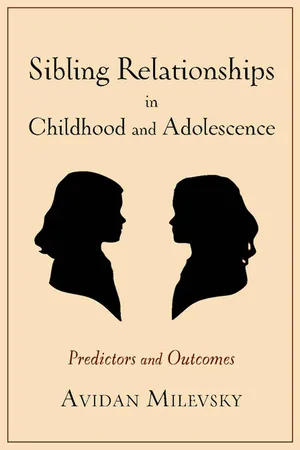
Sibling Relationships in Childhood and Adolescence
Predictors and Outcomes
- English
- ePUB (mobile friendly)
- Available on iOS & Android
About This Book
The most long-lasting and enduring relationship an individual can develop is with a sibling. Considering the closeness in age and early association of siblings, they can bond for a lifetime. Psychologists are beginning to appreciate the sibling link and its dynamic role in a child's social development. Beyond the mother-child dyad, sibling associations are now attributed with determining cognitive faculties, emotional balance, self-sufficiency, and peer interactions.
Clarifying the complex processes of these relationships and the benefit of parental involvement, Avidan Milevsky provides a foundational text for a growing area of study. Deploying personal narrative, theoretical examinations, and empirical data, he unravels the intricacies of the sibling exchange and their function in overall family structures. He identifies the factors that make such bonds successful (or harmful) and the influence of parents in shaping these outcomes. He also evaluates the compensatory possibilities of the sibling bond when faced with the absence of a parent or friend.
Variables such as age, birth order, gender, and family size are tremendous considerations, and parents hoping to enhance the sibling bond gain immensely from understanding these predictors. Milevsky shows practitioners how to educate parents and help them apply their knowledge in practice. He particularly supplies crucial perspective on "deidentification," or conscious differentiation, in which parents encourage different life paths to minimize sibling comparison and competition. A major tool for clinicians, social service providers, and educators, this book clarifies the next frontier in child development research.
Frequently asked questions
Information
Table of contents
- Cover
- Half title
- Title
- Copyright
- Dedication
- Epigraph
- Contents
- Preface
- Acknowledgments
- Introduction
- 1: Structural Variables and Sibling Relationships
- 2: Parenting and Sibling Relationships: Indirect Influences
- 3: Parenting and Sibling Relationships: Direct Influences
- 4: Well-Being and Sibling Relationships
- 5: Compensatory Effects of Sibling Support: Parents
- 6: Compensatory Effects of Sibling Support: Friends
- 7: Sibling Deidentification
- 8: Summary, Application, and Future Directions
- References
- Index